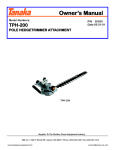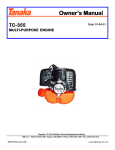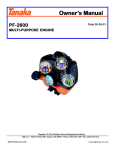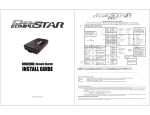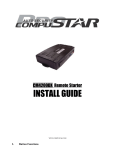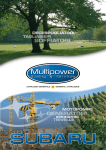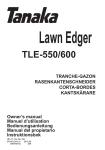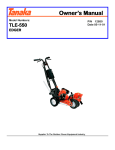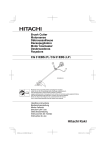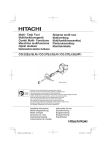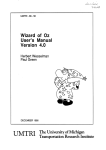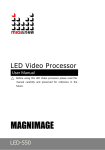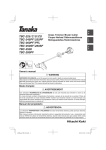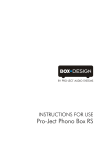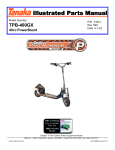Download TBC Service Manual (Newer)
Transcript
SERVICE MANUAL GRASS TRIMMERS / BRUSH CUTTERS • TROUBLE SHOOTING • SERVICE / TORQUE LIMITS • TECHNICAL DATA 1028 4th Street S.W. • Building B • Auburn, WA 98001 • PH: 253-333-1200 • F: 253-333-1212 • tanakapowerequipment.com Introduction How To Use Your Service Manual Replacement Parts This Service Manual is arranged for quick, easy reference When replacement parts are required, use only approved and is divided into numbered sections. parts. Failure to do somayresult in products malfunction and possible injury to operator and/or bystander. NOTE : Read all information for servicing a part or system before repair work is started to avoid needless assembly. NOTE:All referenceto "Left","Right","Front" and "Back" are given from operators position. NOTE: The descriptions and specifications contained in this manual were in effect at the time this manual Preparation For Service was approved for printing. We reserve the right to discontinue models without notice and without Proper preparation is very important for efficient service work. A clean work area at the start of each job will allow incurring ob!igation. The equipment identified as you to perform the repair as easily and quickly as possible, either standard or optional and the various illustraand reduce incidence of misplace tools and parts. A unit tions may not all be applicab!e to your unit. If you that is excessively dirty should be cleaned before work have question, always check with your dealer. starts. Cleaning will occasionally uncover trouble sources. Tools, instruments and parts needed for the job should be gathered before work is started. Interrupting a job to locate tools or parts is a needless delay. Special tools required for a job are listed in this manual. WWW.TANAKAPOWEREQUIPMENT.COM [email protected] Safety Alert Symbol and Notations The following safety notations are used throughout this manual to call attention to special information or operating procedures. Understand the message in each notation and be alert to unsafe conditions and the possibility of personal injury. NOTE: A NOTE points out general reference information regarding proper operation and maintenance practices. IMPORTANT: An IMPORTANT statement indicates specific procedures or information that is required to prevent damage to the machine or its attachments. CAUTION: A CAUTION identifies safe operating practices or indicates unsafe conditions that could result in personal injury. WARNING: A WARNING describes a condition where failure to follow the instructions could result in severe personal injury. DANGER: A DANGER designates a condition where failure to follow instructions or heed warning will most likely result in serious injury or death. This safety alert symbol is used to attract your attention! PERSONAL SAFETY IS INVOLVED! When you see this symbol - BECOME ALERT HEED ITS MESSAGE. Safety Precautions Before test operating or making repairs or adjustments to the unit, read and understand the operating and safety Gasoline is highly flammable and its vapors are explosive. instructions in the Owner’s Manual. Handle with care. Use an approved fuel container. DO NOT smoke or allow open flame (match, pilot light, etc.) or DO NOT make any adjustment or perform any maintesparks near equipment or fuel container when refueling or nance or repair procedures while engine is running servi cing fuel system. unless specifically instructed to do so in this manual. Use non-flammable solvent to clean parts - DO NOT use DO NOT touch parts which might be hot from operation. gasoline. Before attempting to maintain, adjust or service, allow Use only approved replacement parts when making such parts to cool. repairs. Open doors if engine is run in garage, exhaust fumes are dangerous. DO NOT run engine in an enclosed area. Do repair work in a well-lighted, ventilated area. To prevent accidental starting, disconnect wire to spark plug and position wire away from plug. Always wear satety goggles when cleaning or making repairs to parts or machine. When unit is tipped to perform service procedures in this manual, remove all fuel so that no spillage will occur. WWW.TANAKAPOWEREQUIPMENT.COM After all repair procedures are performed, make sure that unit is in good operating condition and all safety devices and shields are in place and in good working condition. Be sure all fasteners are tight, all adjustments are correct and all tools are removed. DO NOT change engine governor setting or over speed engine. Never store equipment with fuel in tank inside a building where fuel fumes may reach an open flame or spark. Allow engine to cool before storing in any enclosure. [email protected] CONTENTS 1. Special tools page 1 2. Technical Data 2 3. Service Limits 4 4. Torque Limits 5 5. General Components & Inspections 1. Crankcase 2. Cylinder 3. Piston 4. Piston pin bore 5. Piston ring end gap 6. Piston ring side clearance 7. Piston pin 8. Crankshaft journal 9. Connecting rod/big end side clearance 10. Eccentricity of crank shaft 11. Centrifugal clutch 12. Spark plug 13. Ignition coil inspection 14. Inspection of cylinder compression 15. Tank cap 6 6 6 6 6 6 7 7 7 7 7 7 8 8 8 9 6. Engine side 6-1 Recoil starter system 6-2 Checking air gap 6-3 Carburetor adjustment and maintenance 6-4 Disassembling and assembling engine 10 10 10 11 12 7. Drive side 7-1 Removing and assembling clutch drum 7-2 Removing drive shaft 7-3 Disassembling gear case 7-4 Assembling gear case 15 15 15 15 16 8. Trouble Shooting 17 WWW.TANAKAPOWEREQUIPMENT.COM [email protected] 1. Special Tool List Ref.# Description Parts# 2 3 4 5 5 7 7 8 9 Fly-wheel remover Center bolt Step bolt 6 x 42 Piston pin remover Piston pin remover Pinion remover Pinion remover Coil locator Remover bolt 8 x 42 006-29326-00 007-29326-00 008-29326-00 009-29323-50 009-29326-00 016-29338-00 016-29373-00 020-29371-14 021-29355-00 10 Gear shaft inserter 28 031-29339-00 10 11 11 11 11 20 Gear shaft inserter 32 Pinion inserter 26 Pinion inserter 28 Pinion inserter 24 Pinion inserter 30 Handle bar 8 x 120 031-29338-00 032-29335-60 032-29338-00 032-29339-00 032-29371-00 951-20000-20 TBC-230/2501 TBC-290 TBC-340 TBC-4200DX TBC-250PF/260PF TBC-340PF TBC-270 TBC-420PF x x 2 x x x 2 x x x x (except TBC230) TBC-550DX TBC-550/600 x x x x x x x x x x x x 2 2 x 2 x 2 x x x x x x x TBC-4200D TBC-4200DLV TBC-430PFLV x 2 x x x x x x x x WWW.TANAKAPOWEREQUIPMENT.COM x x 1 x x x [email protected] x x 2. Technical Data Model Displacement (cc) Bore x Stroke (mm) Compression ratio Max. kW/rpm Max. kg Em/rpm Max. rpm Idling rpm Clutch-meet rpm Carburetor (maker/type ) Fixed Jet (main jet #) L/H needle set Metering lever height (mm) Ignition system Air gap (mm) Ignition timing ( K) Spark plug(maker) Gap (mm) Clutch drum diameter (mm) Gear Ratio Model Displacement (cc) Bore x Stroke (mm) Compression ratio Max. PS/rpm Max. kW/rpm Max. kg Em/rpm Max. rpm Idling rpm Clutch-meet rpm Carburetor (maker/type ) Fixed Jet (main jet #) L/H needle set Metering lever height (mm) Ignition system Air gap (mm) Ignition timing ( K) Spark plug(maker) Gap (mm) Clutch drum Diameter (mm) Gear Ratio TBC-230B series TBC-230 series TBC-250PF series TBC-2501 series 21.1 31 x 28 6.0 : 1 0.63/7500 0.086/5500 11000 3000 ±200 3800 ±200 WYL182 #38 N/A 21.1 31 x 28 6.0 : 1 0.63/7500 0.086/5500 11000 3000 ±200 3800 ±200 WYL182 #38 N/A 23.9 33 x 28 7.3 : 1 0.82/8000 0.12/5500 11000 3000 ±200 3800 ±200 WYJ318 #38 N/A 25.0 34 x 27 7.2 : 1 0.90/7500 0.13/5500 11000 3000 ±200 3800 ±200 WYJ296 # 43 N/A 1.50 ±0.16 (frm face of pump body) 1.50 ±0.16 (frm face of pump body) 1.50 ±0.16 (frm face of pump body) 1.50 ±0.16 (frm face of pump body) TCI (Transistorized Solid State) TCI (Transistorized Solid State) 0.30 - 0.35 ----CJ8Y(CHPN) or RCJ8Y(CHPN) 0.6 54 1.25 : 1 (Curved sfaft 1: 1 ) TBC-270PF series 0.30 - 0.35 ----CJ8Y(CHPN) or RCJ8Y(CHPN) 0.6 54 1.25 : 1 TBC-270 series CDI (Capacitor Discharge Ignition System) 0.30 - 0.35 25 RCJ6Y(CHPN) 0.6 54 1.25 : 1 (Curved sfaft 1: 1 ) TBC-290 series TCI (Transistorized Solid State) 0.30 - 0.35 ----CJ6(CHPN) or BMR7A(NGK) 0.6 54 1.25: 1 TBC-340 series 25.6 33 x 30 8.0 : 1 1.23/8000 0.90/8000 0.12/6000 11000 3000 ±200 3800 ±200 WYJ243 A # 38 N/A 26.9 35 x 28 6.0 : 1 1.24/7000 0.92/7000 0.14/5000 11000 3000 ±200 3800 ±200 WYJ431 # 42 N/A 28.0 34.5 x30 6.8 : 1 1.42/8000 1.05/8000 0.14/4000 11000 3000 ±200 3800 ±200 WYJ392 # 43 N/A 32.2 37 x 30 6.5 : 1 1.6/8000 1.17/8000 0.16/6000 11000 3000 ±200 3800 ±200 WYJ296 # 43 N/A 1.50 ±0.16 (frm face of pump body) 1.50 ±0.16 (frm face of pump body) 1.50 ±0.16 (frm face of pump body) 1.50 ±0.16 (frm face of pump body) TCI (Transistorized Solid State) TCI (Transistorized Solid State) TCI (Transistorized Solid State) 0.30 - 0.35 N/A BPM6A (NGK) or RCY8Y(CHPN) 0.6 54 0.30 - 0.35 N/A RCY8Y(CHPN) 0.30 - 0.35 N/A RCY8Y(CHPN) CDI (Capacitor Discharge Ignition System) 0.30 - 0.35 32 CJ-6Y(CHPN) or RCJ-6Y(CHPN) 0.6 54 1.286 : 1 WWW.TANAKAPOWEREQUIPMENT.COM 1.25 : 1 2 0.6 54 0.6 78 1.28 : 1 1.28 : 1 [email protected] 2. Technical Data Model Displacement (cc) Bore x Stroke (mm) Compression ratio Max. PS/rpm Max. kW/rpm Max. kg m/rpm Max. rpm Idling rpm Clutch-meet rpm Carburetor (maker/type) Fixed Jet (main jet #) L/H needle set Metering lever height (mm) Ignition system Air gap (mm) Ignition timing ( ) Spark plug(maker) Gap (mm) Clutch drum Diameter (mm) Gear Ratio TBC-420PF 430PF series TBC-550 series TBC-600 46.5 43 x 32 7.0 : 1 2.38/7000 1.75/7000 0.26/6000 11500 2800±200 3800±200 HDA180 N/A 90 46.5 43 x 32 7.0 : 1 2.38/7000 1.75/7000 0.26/6000 11500 2800±200 3800±200 HDA180 N/A 90 1.50±0.16 (frm face 1.50±0.16 (frm face of pump body) of pump body) -0.13 0.25 (frm face of carb. body) -0.13 0.25 (frm face of carb. body) TCI (Transistorized Solid State) 0.30 - 0.35 30 CJ8Y(CHPN) or RCJ8Y(CHPN) 0.6 78 TCI (Transistorized Solid State) 0.30 - 0.35 23 BPMR-6A (NGK) 0.6 78 TCI (Transistorized Solid State) 0.30 - 0.35 23 BPM-6A(NGK) or BPMR-6A(NGK) 0.6 78 TCI (Transistorized Solid State) 0.30 - 0.35 23 BPMR-6A(NGK) or BPM-6A(NGK) 0.6 78 1.31 3 : 1 1.313 : 1 1.313 : 1 1.313 : 1 39.8 39.8 x 32 7.2 : 1 1.7/6500 1.25/6000 0.22/5000 11000 3000±200 3800±200 WYJ224B # 44 N/A WWW.TANAKAPOWEREQUIPMENT.COM TBC-4200D series 39.8 39.8 x 32 6.95:1 1.78/7000 1.31/7000 0.21/5000 11500 2800±200 3500±200 WYJ389 # 51 N/A 3 [email protected] 3. Service Limit CYLINDER BORE PISTON / SKIRT OUTER DIA. PISTON PIN BORE PISTON PIN OUTER DIA. CON-ROD BIG END SIDE CLEARANCE CON-ROD SMALL END SIDE CLEARANCE CRANKSHAFT ECCENTRICITY CRANKSHAFT JOURNAL DIA. (PTO) CRANKSHAFT JOURNAL DIA. (STARTER) CLUTCH DRUM INNER DIA. CLUTCH DRUM SHAFT DIA. For ALL MODELS MODEL MAX. MIN. MAX. MIN. MAX. MAX. MAX. MIN. MIN. MAX. MIN. TBC-230B series 31.04 30.80 8.05 7.96 0.50 - 0.10 11.90 11.90 55.00 11.95 TBC-230 series 31.04 30.80 8.05 7.96 0.50 - 0.10 11.90 11.90 55.00 11.95 TBC-250PF series 33.04 32.80 8.05 7.96 0.50 - 0.10 11.90 11.90 55.00 11.95 TBC-2501 series 34.04 33.80 10.05 9.96 0.50 - 0.10 11.90 11.90 55.00 11.95 TBC-270PF series 33.04 32.80 9.05 8.96 0.50 - 0.10 11.90 11.90 55.00 11.95 TBC-270series 35.03 34.80 8.05 7.96 0.50 - 0.10 11.90 11.90 55.00 11.95 TBC-290 series 34.53 34.30 9.05 8.96 0.50 - 0.10 11.90 11.90 55.00 11.95 TBC-340 series 37.03 36.80 9.05 8.96 0.50 - 0.10 11.90 11.90 79.00 11.95 TBC-420PF TBC-430PF series 39.84 39.60 10.05 9.96 0.50 - 0.10 14.90 14.90 79.00 14.95 TBC-4200 series 39.84 39.60 10.05 9.96 0.50 - 0.10 14.90 14.90 79.00 14.95 TBC-550 series 43.04 42.80 10.05 9.96 - 0.50 0.10 14.90 14.90 79.00 14.95 TBC-600 43.04 42.80 10.05 9.96 - 0.50 0.10 14.90 14.90 79.00 14.95 PISTON RING END GAP MAX. 0.80 mm Grass trimmers/Brush cutters PISTON RING SIDE CLEARANCE MAX. 0.15 mm WWW.TANAKAPOWEREQUIPMENT.COM 4 [email protected] 4. Torque Limits SPECIAL FASTENERS Reference kg-cm In-lb Flywheel nut 200 - 230 173.6 - 199.6 Clutch or Special nut Spark plug Carb. insulator 200 - 250 150 - 200 50 - 60 173.6 - 217.0 130.2 - 173.6 43.4 - 52.1 CyIinder 45 - 50 39.1 - 43.4 Crankcase 40 - 50 34.7 - 43.4 ORDINARY NUTS AND BOLTS Reference kg-cm In-lb M4 Screw M5 Screw 20 - 30 40 - 50 17.3 - 26.0 34.7 - 43.4 M6 Screw M4 Nut M5 Nut 60 - 70 20 - 30 40 - 50 52.1 - 60 7 17.3 - 26.0 34.7 - 43.4 60 - 70 25 - 30 45 - 50 80 - 100 200 - 250 52 1 - 60.7 21.7 - 26.0 39.1 - 43.4 69.4 - 86.8 173.4 - 216 8 M6 Hut M4 Hex hole bolt M5 Hex hole bolt M6 Hex hole bolt M8 Bolt WWW.TANAKAPOWEREQUIPMENT.COM 5 [email protected] Sealing is essential. Fig. 1 WWW.TANAKAPOWEREQUIPMENT.COM 6 [email protected] WWW.TANAKAPOWEREQUIPMENT.COM 7 [email protected] WWW.TANAKAPOWEREQUIPMENT.COM 8 [email protected] WWW.TANAKAPOWEREQUIPMENT.COM 9 [email protected] 6. ENGINE SIDE 6-1 Recoil Starter System NOTE: Never disassemble Spring Case Assy. You may get hurt. 1) Remove recoil starter body assy from unit. 2) Pull starter handle, then hold rope reel and pull starter rope out from ropoe reel. Fig. 15 3) While holding rope reel, let recoil spring unwind slowly. Then remove the holding screw from the center of the recoil body Fig. 16 6) Check for wear and/or damage to the starter pawl and spring on the starter pulley and replace as necessary. Fig. 18 Caution: When removing starter pully or starter reel, The recoil spring may fly out. Eye/Face protection is recommended when replacing recoil spring. 6-2 Checking Air Gap 1) Check if the gap between the ignition coil and the rotor is 0.3 mm (With two 0.15 mm thickness gauge’s) 2) If the measured gap is not 0.3 mm, adjust the gap to 0.3 mm using the rotor gap thickness gauge on both cores. Rotor gap thickness gauge 020-29371-14 TBC-550/DX/600 O O NOTE: The screws must be fastened in 1 to 2 order to prevent the air gap from widening. NOTE: Never rotate magneto rotor clockwise to avoid recoil starter damage when it is installed. 4) Check for any wear and/or damage on the individual recoil parts (rope reel, recoil spring, starter rope, damper spring, cam plate, spring case assy. , ect.) and replace as necessary. Fig. 16 5) When assembling the recoil spring to the recoil body, insert hook of recoil spring into the groove within the recoil starter body. Fig. 17 NOTE: Be sure to install recoil spring so shape spring winding is clockwise from the center to out. WWW.TANAKAPOWEREQUIPMENT.COM 10 [email protected] Needle Pin WWW.TANAKAPOWEREQUIPMENT.COM 11 [email protected] C. To maintain carburetor performance, it is recommended that rubber parts be inspected periodically or whenever disassembled. Check diaphragm for deterioration or damage, valve hinge for deformation and needle valve for wear. Always use fresh fuel. Fuel which has been stored for an extended periods of time will damage carburetor parts and decrease performance. NOTE: Make sure not to damage the end of the crankshaft, when removing the magneto rotor. Carburetor performance us effected slightly by weather, altitude, break-in, etc. But it is generally not necessary to adjust the carburetor. If carburetor floods, check the needle valve for wear. Also check valve hinge adjustment and carburetor adjustment (see section A and B). 4) Carburetor Insulator If the engine will not run smoothly after checking and adjusting the carburetor, check insulator. Fig 23 A. B. 3) After removing the muffler bolts, remove muffler and muffler gasket. NOTE: Inspect muffler for carbon build-up and clean or replace as necessary. Fig. 25 Check alignment for pulse hole of insulator, inlet manifold gasket and cylinder. Check for any damage and replace as needed. Check flat surface of insulator where the cylinder and carburetor are installed. If uneven, make flat by using fine sandpaper or replace as needed. NOTE: When assembling insulator on the unit, always replace inlet manifold and carburetor gasket. 4) When installing clutch assy onto the unit, make sure of the direction of the clutch. Fig. 25-1 NOTE: Check for any wear or damage before installation of clutch and replace as necessary. NOTE: If clutch assy is installed in reverse on the unit, you will not get smooth engagement at low rpm. Disassembling and Assembling Engine 6-4 1) To separate engine side and drive side, disassemble at fan case or clutch case from drive shaft pipe and also disconnect stop cords and throttle wire. 2) Remove magneto rotor tightening nut and remove magneto rotor from the crankshaft by using the following special tools. Fig 24 1. Fly-Wheel Remover 2. Center Bolt 3. Step Bolts or Remover Bolts 4. Handle Bar 8 X 120 (See section 1. Special Tools List) WWW.TANAKAPOWEREQUIPMENT.COM 12 [email protected] 4) Remove the screws securing cylinder and pull cylinder off of the crankcase, before installing cylinder apply a thin coat of oil to the piston. B. Apply a coat of grease to the lip of each oil seal, then install shims on the starter side of the crankshaft and insert crankshaft into the crankcase. Align each piston ring with the locator pin, slowly insert piston into cylinder while compressing the rings in with your fingers. NOTE: After tightening the crankcase screws, move the crankshaft to one side and measure the crankshaft side play with a feeler gauge. Install shims on the starter side of the crankshaft to adjust clearance, which should be 0.1 - 0.3mm. Fig. 29 Then install and tighten the cylinder screws. Fig. 26 CHECK: Cylinder for wear and damage, exhaust port for carbon build-up and cylinder fins for debris. Fig. 27 6) Remove ring/s from the piston by separating the ring with your thumbs just enough to get it off of the piston. CHECK: Wear on piston ring/s and replace as necessary. Fig. 30 5) Disassembling and assembling crankcase A. Before separating crankcase, make sure woodruff key is removed, then remove the crankcase screws. To divide crankcase, lightly tap crankshaft with a soft hammer, taking care not to damage the crankcase fitting surface and remove the crankshaft. Fig. 28 CHECK: 1. For any damage to the ball bearing and oil seal. 2. Rod bearing for damage and clearance. NOTE: Use a new crankcase gasket and cut off excess gasket material when assembling. WWW.TANAKAPOWEREQUIPMENT.COM 13 [email protected] WWW.TANAKAPOWEREQUIPMENT.COM 14 [email protected] 7. DRIVE SIDE 7-1 Removing and assembling clutch drum 1) Remove stop ring from clutch drum using long nose snap ring pliers. Fig.33 2) Then remove clutch drum from fan case or clutch case using handle bar 8x120 from the stop ring side. 3) Some ball bearing holding clutch drums can be removed from fan case or clutch case using the snap ring pliers after removing clutch drum. NOTE: Check for any wearing of the inner diameter of clutch drum and /or splines and/or any other parts and replace as necessary. 4) When assembling clutch drum on fan case or clutch case, always use a new stop ring. 7-2 Removing drive shaft 1) Pull out drive shaft from drive shaft pipe and check any wear and/or damage and replace as necessary. 2) When installing drive shaft into drive shaft pipe, apply lithium based grease over drive shaft. To extend the drive shaft life, reverse drive shaft. 7-3 Disassembling gear case Fig.34 1) Remove fixing nut, cutter holder cap and cutter holder. And then remove stop ring using snap ring priers. 2) Install fixing nut on gear shaft until fixing nut is flush with the end of gear shaft. 3) Hold fixing nut securely with the vice. 4) Hit gear case using soft hammer until gear shaft and ball bearing come out from gear case. 5) After removing gear shaft, remove stop ring which secures ball bearing. Fig.35 6) Remove pinion and ball bearings using one of the pinion removers shown on the special tool list. NOTE; When replacing gear and pinion, replace gear and pinion as one set. 7) To remove pinion from bearings, remove stop ring first, then place pinion and bearings between a pair of suitable metal stands. Insert drive shaft which has been cut short into pinion, then tap the short drive shaft slightly to remove pinion from bearings. Fig.36 8) If bearing where it is installed in the bottom of gear case needs to be replaced, heat the bottom of gear case up to 100 degrees to 150 degrees and then tap gear case to wooden base so that bearing Fig.36 will come off. WWW.TANAKAPOWEREQUIPMENT.COM 15 [email protected] 7- 4 Assembling gear case 1) Install ball bearing into the bottom of gear case using the proper daimeter installer. See below for diameters. Dia. 20mm ----- TBC-230 series Dia. 24mm ----- TBC-2501/250PF/260PF/270 series, TBC420PF TBC-4200D/DLV/430PFLV/550/600 2) Apply grease on gear shaft and insert it into ball bearing which was installed in section 1) using one of gear shaft inserter’s shown on the Special tool list. Fig.37 3) Insert ball bearing into pinion using one of the pinion inserters which are shown on the Special Tool List. Fig.38 4) Install the pinion installed bearings by gradually turning the gear shaft so that the pinion engages properly with gear, and then press in using pinion inserter and install the stop ring in place using long nose snap ring pliers. NOTE: When installing the stop ring, always use a new stop ring. WWW.TANAKAPOWEREQUIPMENT.COM 16 [email protected] 4. Trouble Shooting Engine doesn't crank Check recoil starter system Check internal engine parts Check spark plug No spark or weak spark Bad connection/ignition coil Incorrect air gap/ignition coil Bad ignition coil Engine won't start Clogged fuel filter Clogged or incorrect of air vent valve on engine case Engine cranks Fuel doesn't reach cylinder Air leak at intake Air leak from engine Clogged and/or leaks pulse to carburetor Air leak from fuel pipe Air leak from carburetor Incorrect carburetor adjustment Bad diaphragm in carburetor Incorrect carburetor valve hinge height adjustment Bad fuel-Use proper/fresh fuel Fuel and spark reach cylinder Engine flooded-Check carburetor Muffler gasket partially covering exhaust port of cylinder Excess carbon in muffler/spark arrestor Poor cylinder pressure Worn or damaged internal parts WWW.TANAKAPOWEREQUIPMENT.COM 17 [email protected] Power is low or poor Carbon deposits in muffler Poor cylinder pressure Dirty air cleaner element Incorrect carburetor adjustment Worn or damaged internal parts Runs inconstantly Bad spark plug Bad ignition coil Incorrect carburetor adjustment Engine doesn't run properly Air leak at intake Air leak from fuel pipe Lean carburetor adjustment Clogged fuel filter Doesn't accelerate Engine isn't warm enough, Warm up engine Lean carburetor adjustment Air leak at intake Air leak from pipe Clogged fuel filter Engine RPM surging Cutting attachment doesn't turn Broken clutch shoes Clutch shoes worn out Shoes sticking on clutch step bolts Clutch drum broken or worn out Check clutch Check gear case Broken pinion/gear Broken gear shaft Check drive shaft WWW.TANAKAPOWEREQUIPMENT.COM Broken drive shaft or rounded off at spline 18 [email protected]






















